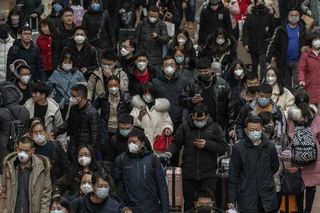
The Coronavirus Outbreak Has Reached India. Here’s What You Need to Know.
The World Health Organization has declared the coronavirus outbreak an international public health emergency.

As it is with infectious viral outbreaks, things are moving fast. On December 31, 2019, doctors apprised the World Health Organization (WHO) of a group of cases of pneumonia from an unknown cause in Wuhan, China. Nine days later, the WHO issued a statement saying Chinese researchers had made a “preliminary determination” of the virus as a new strain of coronavirus. As of Feb. 4, 2020, this infectious viral outbreak has claimed 425 lives and has infected over 20,438 people across 27 countries until now and this toll is increasing exponentially.
Three cases of Coronavirus have been reported in Kerala — all three have been isolated and are currently stable. The state, however, has declared an ’emergency.’ Across India, several hundred people either returning from Wuhan or showing symptoms similar to that of the virus are either under observation or have been isolated in special wards in several cities such as Delhi, Jaipur, Bihar, Bengaluru, and Kerala.
The World Health Organization has declared the outbreak an international public health emergency. The U.S. stock market has taken a hit, while China has pulled the shutters down on its stock market until February 3. More than 40 million people in China are on lockdown, including in Wuhan, as the country scrambles to build 1000-bed hospitals from scratch in a matter of days to be able to isolate patients with care. Meanwhile, countries across the world have imposed travel advisories for those visiting China, with countries such as India, U.S. and France evacuating its citizens who are stuck there and Russia and Hong Kong closing its borders with the country.
All signs point to the fact that we could be dealing with the first global public health crisis of the new decade. It has all the markings to become a pandemic (when an infectious disease spreads rapidly to many people across several countries) worse than the 2002-03 SARS outbreak, which also originated in China and claimed more than 700 lives across South Asia, infecting over 8,000 people.(The number of people infected by the novel coronavirus has already surpassed the SARS infection toll.) But there’s little we can do apart from being informed and taking precautions. Forewarned is forearmed, so here’s everything you need to know about the latest virus outbreak:
Related on The Swaddle:
Flu‑Like Viral Pandemic Will Soon Kill 80 Million, Wipe Out 5% of World Economy
What is a coronavirus?
Coronaviruses are a family of viruses known to infect mostly animals, but which are capable of jumping over the species barrier and infecting humans as well. This results in a range of symptoms, from the less severe common cold to more severe respiratory diseases. The latest outbreak is due to a new, previously unidentified kind of coronavirus, just like the Severe Acute Respiratory Syndrome (SARS) and the Middle East Respiratory Syndrome (MERS) outbreaks, which were also caused by different strains of coronaviruses. The all-too-familiar common cold is also caused by a type of coronavirus.
Researchers have labeled the new strain of the virus as 2019-nCoV, colloquially also called the Wuhan Coronavirus after the outbreak’s epicenter.
How was it detected?
A week after researchers apprised the WHO about the outbreak, they were able to eliminate all causes except one: a novel strain of coronavirus that hadn’t been encountered in humans before. They were able to do this by sequencing the genome using an isolate taken from an infected patient. Five days later, the Chinese government shared the genetic sequence of the virus so that other countries could develop their own treatments against it.
How does the virus spread?
The virus appears to have originated from a Wuhan seafood market where wild animals, including birds, rabbits, bats, and snakes, are traded illegally. Coronaviruses present in animals genetically mutate and cross the species barrier to infect humans, so researchers think that the first people infected with the disease – a group mostly made of stallholders from the seafood market – contracted it from contact with animals.
Initial theories suggested the virus jumped from snakes to humans; a recent study found that the new coronaviruses’ genetic makeup is 96% identical to that of a coronavirus found in bats (also the original source of the SARS virus). Another set of researchers believe that it may have resulted from separate viruses in bats and snakes recombining. This could have happened in the wild, but may also have occurred in the market, where the animals are kept in close proximity.
The Chinese government has shut down the Wuhan market for inspection and cleaning and suspended its wildlife trade until further notice.
But now, animals may be out of the picture. On January 21, the WHO said that the disease had started spreading from human to human after several medical staff caring for patients took ill and tested positive for the virus.
Significantly, on Thursday, the World Health Organization declared the outbreak as a public health emergency on account of several cases being reported across the world of people testing positive for the virus, even though they had never traveled to China.
Related on The Swaddle:
Good and Bad News About India’s Zika Virus Outbreak
How contagious and deadly is it?
Coronaviruses essentially spread via water droplets suspended in the air, through coughing or sneezing. Touching or shaking hands with an infected person, or even just a surface with the virus on it, and then touching one’s eyes, nose or mouth can also lead to the virus spreading. Catching a coronavirus infection can be fatal.
To understand how contagious and deadly the new strain of coronavirus is, it’s important to keep an eye out on two numbers. First, the virus’ RO or reproduction number that measures its contamination rate — that is, how many people can be infected by one patient. Currently, it’s estimated to be between 1.4 and 2.5 — that is, one person can infect anywhere between 14-25 people. But, Chinese experts say the R0 closer to 3.3-5.5. Second, the virus’s fatality rate — that is the percentage of deaths among the infected. As of Jan. 29, this number was 2.2%. In comparison, the numbers for SARS were 10% with an RO of 2 to 5.
In a big development on Jan. 26, the Chinese government warned that the virus is infectious even during its incubation period — unlike SARS, which puts us in even more of an unexplored territory as researchers race to beat the virus. Translation: a person can infect others even before the symptoms show. The incubation period can range from one to 14 days.
What are the symptoms of this type of coronavirus?
Symptoms of coronaviruses are usually mild and similar to other respiratory diseases including the common cold: runny noses, headaches, feeling tired, coughs, and fevers. But in some cases, they can lead to more serious respiratory tract illnesses including bronchitis and pneumonia.
If you have symptoms, ask yourself the following questions:
- Have you traveled to China or a high-risk area like Hong Kong in the last two weeks?
- Have you been in contact with someone who has?
If the answer to either or both is yes, inform your doctor, preferably via a phone call to avoid spreading the infection as can happen in hospital waiting rooms — and then schedule a checkup promptly.
Are some groups more at risk for it?
Big picture? Anyone can get infected. Children as young as 15 and men as old as 88 have been infected until now. But, as is the case with most respiratory illnesses, it is likely to be the very young and very old who are most at risk once infected. For reference, those over age 65 and infants under the age of two have a reduced chance of surviving pneumonia compared to other age groups. The disease can also be particularly dangerous for people who have pre-existing health conditions and/or a weakened immune system.
How far and quickly has the virus spread already?
China has borne the brunt of coronavirus infections and fatalities (so far). As of Jan. 31, Chinese health authorities have acknowledged over 20,000 cases and 423 deaths. But it’s China, and we never really know what’s happening behind the Big Red Firewall; latest research suggests that the number of documented cases in Wuhan is likely only 5% of those infected. The actual number of cases is closer to 120,000 with experts warning that it’s only going to get worse. An unverified video of a nurse in a hazmat suit also went viral around the same time in which she claims that the actual number of cases in Wuhan is 90,000.
Two deaths have occurred outside China — in the Philippines and Hong Kong.
26 other countries — including the U.S., France, Japan, South Korea, Taiwan, Singapore, Thailand, Australia, Nepal, Vietnam, Hong Kong, Macau, Malaysia, Canada, Cambodia, Sri Lanka, Germany, UAE, India, Philippines, Finland, U.K., Sweden, Italy, Russia, and Spain — have reported over 150 cases of the infection as of Jan. 31. No deaths from the virus have taken place outside China (so far).
Related on The Swaddle:
What You Need To Know About Swine Flu
What is the treatment for patients infected with the coronavirus?
We do not have a specific antiviral treatment for the infection yet, so those with the virus are treated for their symptoms. In more severe cases, the virus can cause pneumonia. Viral pneumonia cannot be treated with antibiotics and, so far, there are no antiviral drugs for this particular virus. Instead, doctors focus on supporting patients’ lung function as best they can.
Researchers are working hard and fast to come up with a diagnostic kit to treat this infection — after health authorities in China shared information on the genome of the virus, researchers in Australia were able to grow the coronavirus in a lab, giving them the ability to actually validate and verify all test methods against the virus. Meanwhile, doctors in Thailand are seeing encouraging results when they use a cocktail of flu and HIV drugs for patients who have tested positive for the novel coronavirus.
What are some precautions you can take?
The WHO advises people to:
- Make hand-hygiene their first line of defense. Frequently wash their hands with an alcohol-based hand rub or warm water and soap, especially before and after eating.
- Avoid touching the mouth, nose or eyes with unwashed hands – something people do unconsciously on average about 15 times an hour.
- Cover their mouth and nose with a flexed elbow or tissue when sneezing or coughing.
- Avoid close contact with anyone who has a fever or a cough.
- Seek early medical help if they have a fever, cough and difficulty breathing, and share their travel history with healthcare providers.
- Avoid direct, unprotected contact with live animals and surfaces in contact with animals when visiting live markets in affected areas.
- Avoid eating raw or undercooked animal products and exercise care when handling raw meat, milk or animal organs to avoid cross-contamination with uncooked foods.
When it comes to the efficiency of face masks in preventing transmission and infection of the virus (or any airborne disease), experts remain divided. Given the number of times we tend to touch our face in the day, masks can, to some extent, prevent hand-to-mouth transmission of the disease and help lower the risk of contracting a virus through the “splash” from a sneeze or a cough. At the same time, Dr. David Carrington, of St George’s, University of London, told BBC News that “routine surgical masks for the public are not effective protection against viruses or bacteria carried in the air,” because they were too loose, had no air filter and left the eyes exposed.
The consensus seems to be that wearing a mask can limit – but not eliminate – the risks of catching an infection, provided they are used correctly: Securing them over the mouth, chin, and nose, using the metal strip at the top, pressing against the contours of the nose. WHO experts also advise against wearing gloves for protection, stressing that hand-washing is more important and those who wear gloves are less likely to do so thinking their hands have remained protected, and hence, clean.
After this, all there’s left to do is be informed about the latest updates about the outbreak and place our faith in medical science to save us from yet another doomsday threat, as it did with SARS and MERS, Swine Flu, Zika, and Ebola.
Pallavi Prasad is The Swaddle's Features Editor. When she isn't fighting for gender justice and being righteous, you can find her dabbling in street and sports photography, reading philosophy, drowning in green tea, and procrastinating on doing the dishes.
Related


Everything You Need to Know About Hair‑Oiling, According to Ayurveda
